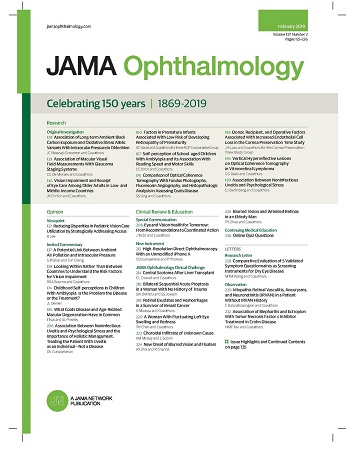Pixel Intensity to Estimate Choroidal Tumor Thickness Using 2-Dimensional Ultra-Widefield Images
IF 7.8
1区 医学
Q1 OPHTHALMOLOGY
引用次数: 0
Abstract
ImportanceTumor thickness is a well-established risk factor for malignant transformation of choroidal nevus into melanoma. To date, reliable evaluation of tumor thickness relies on B-scan ultrasonography, which is frequently unavailable at nonsubspecialty clinics where most melanocytic choroidal lesions (MCLs) are first diagnosed.ObjectiveTo describe a technique for potential rapid and reliable estimation of MCL thickness using only Optomap ultra-widefield (UWF) images without B-scan ultrasonography.Design, Setting, and ParticipantsThis retrospective, exploratory, cross-sectional analysis of consecutive MCLs diagnosed at Byers Eye Institute, Stanford University, Palo Alto, California, investigates the quantitative correlation between B-scan ultrasonographic thickness of MCLs with the relative pixel intensity of MCLs on green-channel (GC) Optomap UWF images. Pixel intensity overlying the lesion was standardized to the pixel intensity surrounding the lesion (pixel intensity difference [PID]), which was then correlated with ultrasonographic tumor thickness in all study lesions using linear regression analysis. Data were collected from January 1, 2019, to July 1, 2021.Main Outcomes and MeasuresThe correlation between ultrasonographic tumor thickness and PID was measured. Performance (sensitivity and specificity) of the regression analysis trendline in estimating tumor thickness was also determined.ResultsA total of 138 MCLs from 138 patients (mean age, 57.0 years; 51% female) were included, comprising 125 that were nevi and 13 that were melanoma. The mean ultrasonographic tumor thickness was 1.1 mm (median, 0.8 mm; range, 0.2-5.5 mm), with a mean PID of 2.13. Stratifying lesions by ultrasonographic thickness (<1.0 mm vs 1.0-2.0 mm vs >2.0 mm), the mean PID increased (−1.95 vs 3.72 vs 17.62;利用二维超宽视场图像估计脉络膜肿瘤厚度的像素强度
肿瘤厚度是脉络膜痣恶性转化为黑色素瘤的危险因素。迄今为止,肿瘤厚度的可靠评估依赖于b超扫描,这在非亚专科诊所经常不可用,大多数黑素细胞脉络膜病变(mcl)是首次诊断。目的探讨一种不经b超扫描,仅利用Optomap超宽视场(UWF)图像快速、可靠地估计MCL厚度的方法。设计、设置和参与者本研究回顾性、探索性、横断面分析了在加州帕洛阿尔托斯坦福大学拜尔斯眼科研究所诊断的连续mcl,探讨了mcl的b超厚度与mcl在绿色通道(GC) Optomap UWF图像上的相对像素强度之间的定量相关性。将病灶上覆盖的像素强度标准化为病灶周围的像素强度(像素强度差[PID]),然后使用线性回归分析将其与所有研究病灶的超声图像肿瘤厚度相关。数据采集时间为2019年1月1日至2021年7月1日。主要观察指标:测量超声影像肿瘤厚度与PID的相关性。并确定回归分析趋势线在估计肿瘤厚度方面的性能(敏感性和特异性)。结果138例患者共检出138个mcl,平均年龄57.0岁;51%为女性),其中痣125例,黑色素瘤13例。超声示肿瘤平均厚度1.1 mm(中位数0.8 mm;范围0.2-5.5 mm),平均PID为2.13。超声厚度分层病变(<1.0 mm vs 1.0-2.0 mm vs >2.0 mm),平均PID增加(- 1.95 vs 3.72 vs 17.62;P, amp;肝移植;.001),平均厚度增加(0.5 mm vs 1.4 mm vs 3.3 mm;P, amp;肝移植;措施)。PID与肿瘤厚度相关(R2 = 0.823;95% ci, 0.770-0.875;P, amp;肝移植;.001)。结论和相关性在这项原则性的研究中,气相色谱得出的病变强度与超声成像的肿瘤厚度具有良好的相关性。利用这种相关性,本研究展示了一种使用UWF Optomap图像而不使用b超扫描的潜在可靠和快速估计肿瘤厚度的技术。
本文章由计算机程序翻译,如有差异,请以英文原文为准。
求助全文
约1分钟内获得全文
求助全文
来源期刊

JAMA ophthalmology
OPHTHALMOLOGY-
CiteScore
13.20
自引率
3.70%
发文量
340
期刊介绍:
JAMA Ophthalmology, with a rich history of continuous publication since 1869, stands as a distinguished international, peer-reviewed journal dedicated to ophthalmology and visual science. In 2019, the journal proudly commemorated 150 years of uninterrupted service to the field. As a member of the esteemed JAMA Network, a consortium renowned for its peer-reviewed general medical and specialty publications, JAMA Ophthalmology upholds the highest standards of excellence in disseminating cutting-edge research and insights. Join us in celebrating our legacy and advancing the frontiers of ophthalmology and visual science.
 求助内容:
求助内容: 应助结果提醒方式:
应助结果提醒方式:


